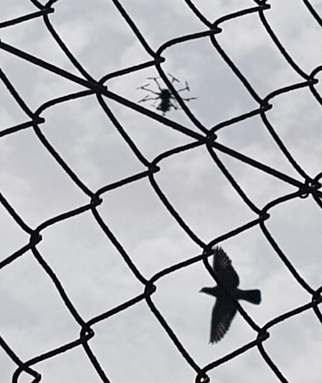David Eldridge, Sales Director, Chess Dynamics discusses the securing of critical infrastructure against the rising threat of Unmanned Aerial Systems (UASs) – or drones.
They present a significant and increasing risk for all industries. For critical infrastructure like power stations, transport hubs and networks, along with other key amenities, UASs can be a real threat to security and public safety. In 2018, a UAS was flown and crashed into a French nuclear power station by Greenpeace activists aiming to highlight how nuclear power stations are “easily accessible and extremely vulnerable to external attacks”. In the UK, a main bridge route between England and Wales was closed after a UAS was flown from the top of it and posed a risk to the safety of road users underneath. Clearly, these easily obtainable and relatively inexpensive devices have the potential to cause travel disruption on a wide scale.
UASs pose a dual risk of rogue surveillance operations that compromise the security efforts surrounding restricted areas, as well as the threat carried by their ability to be weaponised by carrying explosives or other payloads, which endanger life and have the potential to bring essential services to a standstill.
For these reasons, countering the malicious and unsafe use of UASs has become an increasingly urgent legislative priority. Introduced to help reduce the risk from unregistered drones, new regulation states that UK drone pilots have until the end of November 2019 to register their information with the Civil Aviation Authority (CAA). The register will cover all UASs that weigh more than 250g, with those registered needing to pass an online test about using the device safely. Not only does this legislation aim to reduce the malicious use of UASs, but it can also be used to locate drone owners if devices are detected.
Added to this, in October 2019 the Government announced a new specialist mobile counter-drone unit that will be available to police forces and law enforcement agencies across the UK. The ‘detect and destroy’ technology will be used to counter potential threats at major events and critical infrastructure. The unit is part of the Government’s three-year strategy to tackle the ongoing challenges surrounding the malicious use of UAS technology. These positive measures will support a move to reduce the risk associated with UASs, but many organisations are starting to take a proactive stance in protecting their infrastructure. Counter-UAS technologies have already been deployed in sectors where malicious drones have posed a serious risk, providing a blueprint for other industries.
A closer look at the aviation sector
Drone incidents reported to UK police forces rose by 40 per cent between 2016 and 2018 to 2,400 incidents, including dozens of reports of drones being flown within the flightpaths of airports – prompting the aviation sector to look to the Government, military, police and technology providers for support. Chess’s military counter-UAS solution was brought into use at London Gatwick Airport in December 2018 following the sustained drone incident. The system remains part of the overall security solution at the airport. However, to meet the specific needs of the civilian environment and the unique challenges that it presents, we have evolved this military-proven technology to offer a scalable solution for all civilian and commercial environments.
The challenges faced by airports are similar in several respects to the risks posed to critical infrastructure. For example, a key issue in both types of environment is the number of vehicles, people and equipment moving around at any one time that the surveillance technology will detect but does not need to report. The operational cost and burden on manpower needed to operate such a system, which needs to be functional 24/7/356, also needs to be considered.
Unlike in the military context, there is not a dedicated workforce available to monitor the counter-UAS equipment and equally, there is rarely a ‘always on’ chain of command for decision making. So, for these sectors it’s vital that the technology can be automated, and is intuitive, easy to use and as efficient as possible. As with any countermeasure, the Chess counter-UAS product offering has to be configurable and easy to update as the threat evolves and the method of dealing with it changes. To date, applications have included numerous areas and critical infrastructure, both fixed and mobile.
Detect, track and identify
Based on the unique security requirements for airports, Chess launched two separate solutions – AirGuard and AirShield – to enable UASs to be detected, tracked and identified in civilian aviation environments. The systems will automatically detect and track airborne objects using radar, radio frequency direction finders and electro-optical video tracking technology. An alert is then flagged to the operator who can classify the object and use the system to escalate or downgrade the security threat based on real-time information. This allows the onsite security team to take control of the situation by identifying the UAS and the path it is taking before escalating the situation accordingly.
To support with the prosecution of operators using UAS technology maliciously or unsafely, the system can also provide security agencies with accurate information and recorded video evidence. To complement fixed counter-UAS systems, modular and mobile capabilities based on the same fundamental technologies are available and can be rapidly deployed to detect and track drones where a threat is identified outside of a protected area.
The use of UAS technology to infringe on critical infrastructure presents an increasing risk to national security. By looking to other sectors with experience tackling UAS incursions such as commercial aviation, security professionals can identify capabilities and processes that can offer protection to specific industries or facilities. These capabilities not only act as a deterrent but mitigate the risk to safety and security and support the prosecution of offenders.
About the firm
Chess marries mechanical and electro-optical (EO) engineering with video management software. Visit: http://www.chess-dynamics.com/. The firm has its own software house, so is able to offer complete bespoke EO surveillance packages.










